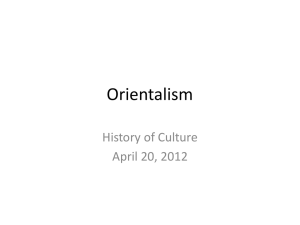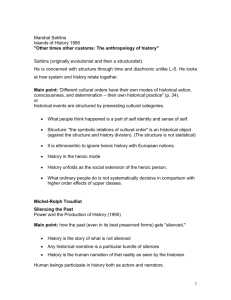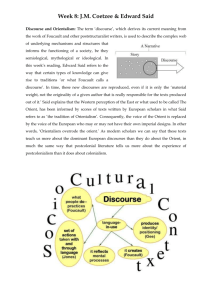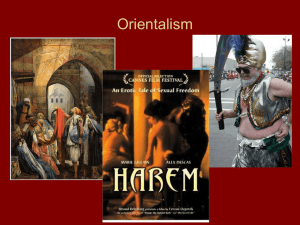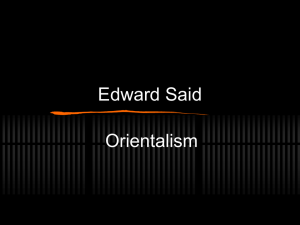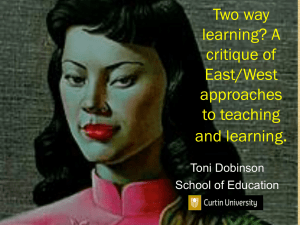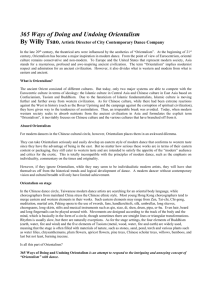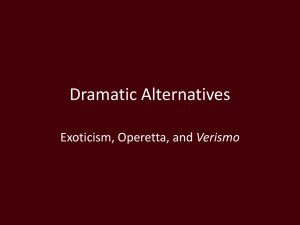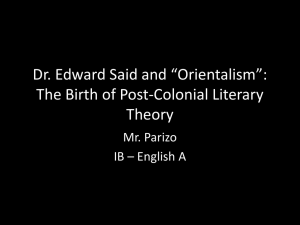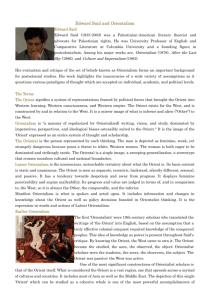(Re)orienting Orientalism
advertisement
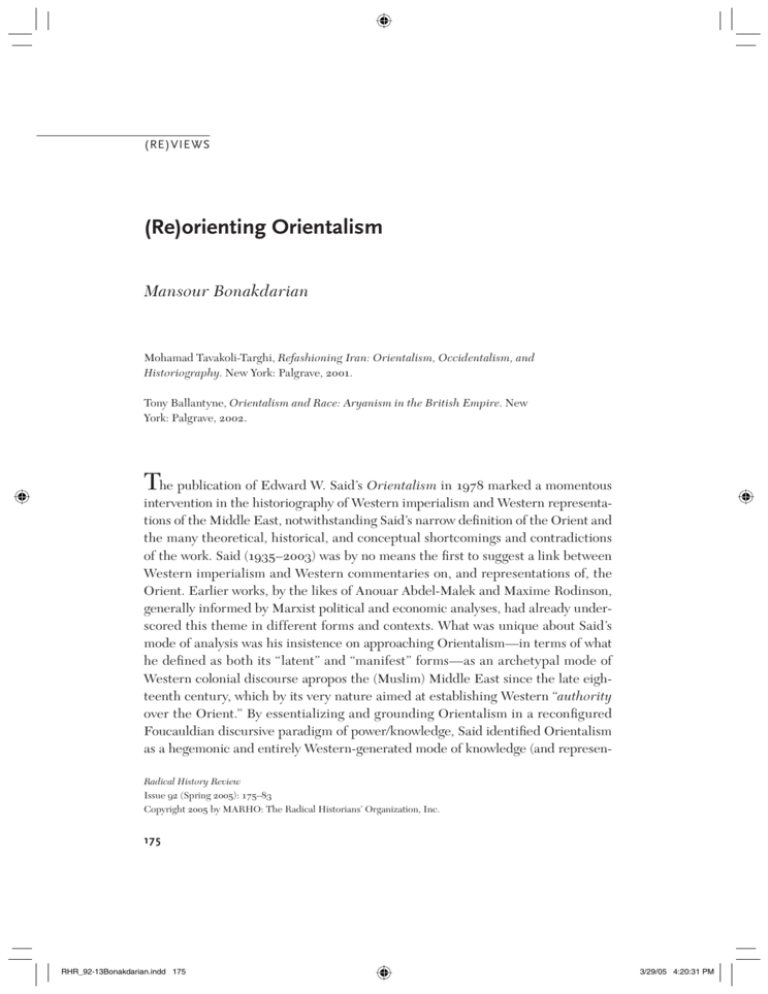
(RE)VIEWS (Re)orienting Orientalism Mansour Bonakdarian Mohamad Tavakoli-Targhi, Refashioning Iran: Orientalism, Occidentalism, and Historiography. New York: Palgrave, 2001. Tony Ballantyne, Orientalism and Race: Aryanism in the British Empire. New York: Palgrave, 2002. The publication of Edward W. Said’s Orientalism in 1978 marked a momentous intervention in the historiography of Western imperialism and Western representations of the Middle East, notwithstanding Said’s narrow definition of the Orient and the many theoretical, historical, and conceptual shortcomings and contradictions of the work. Said (1935–2003) was by no means the first to suggest a link between Western imperialism and Western commentaries on, and representations of, the Orient. Earlier works, by the likes of Anouar Abdel-Malek and Maxime Rodinson, generally informed by Marxist political and economic analyses, had already underscored this theme in different forms and contexts. What was unique about Said’s mode of analysis was his insistence on approaching Orientalism—in terms of what he defined as both its “latent” and “manifest” forms—as an archetypal mode of Western colonial discourse apropos the (Muslim) Middle East since the late eighteenth century, which by its very nature aimed at establishing Western “authority over the Orient.” By essentializing and grounding Orientalism in a reconfigured Foucauldian discursive paradigm of power/knowledge, Said identified Orientalism as a hegemonic and entirely Western-generated mode of knowledge (and represenRadical History Review Issue 92 (Spring 2005): 175–83 Copyright 2005 by MARHO: The Radical Historians’ Organization, Inc. 175 RHR_92-13Bonakdarian.indd 175 3/29/05 4:20:31 PM 176 Radical History Review tations) imbued with an underlying fundamental discursive will to vilify and dominate the Oriental other.1 Since 1978, numerous critics have inventoried the various limitations, overgeneralizations and theoretical and analytical inconsistencies of Said’s work. These have included a host of progressive, anti-imperialist commentators, many of whom have simultaneously acknowledged Said’s own progressive commitments and/or the many valuable contours and contributions of Orientalism and its significance in reanimating new sets of highly illuminating, cross-disciplinary, and more comprehensive heuristic inquiries and debates in confronting past and ongoing forms of imperialism and other modes of exploitation (within and beyond the matrices of West-Orient encounters since the late eighteenth century).2 The scope of these critiques have ranged, among others, from Said’s essentialist treatment of the West to his construction of an equally homogeneous Orient, his imposition of a particular reading of Orientalism onto the entire range of academic and nonacademic modes of Western representations of and encounters with the Middle East, his inadequate attention to themes of class and gender, his elision of varying manifestations of Western imperialism with all Western expressions of cultural alterity vis-à-vis the Orient, and his insufficient attention to the interplay between intended political effects of imperialism and Western (mis)representations of the Orient, such as whether misconceptions about and misrepresentations of the Orient would not at some level hinder the presumed desiderata of Western imperial domination of oriental societies. Among Said’s critics have also been the advocates of Western civilizational superiority, as well as apologists of the pernicious legacies of Western imperialism and defenders of current U.S. neo-imperialism and Israeli territorial and military aggression, such as Bernard Lewis, Martin Kramer, Daniel Pipes, and Samuel P. Huntington. This category of Said’s detractors, variously asserting a sweeping Oriental (in this case, Middle Eastern Muslim) intellectual and cultural dormancy since at least the eighteenth century, as well as an ostensibly fundamental retrograde civilizational attribute of Islam, in fact fit Said’s otherwise stereotypic archetype of Orientalists advancing and legitimizing Western imperialism and cultural chauvinism through self-centric and self-serving devaluation and demonization of a putatively homogenized oriental/Muslim Other. Nonetheless, a common underlying premise of this latter category of Said’s critics and many of the more discerning and judicious critics is their ultimate concurrence with Said’s supposition that Orientalism was/is a sui generis Westerngenerated mode of knowledge. Hence, frequently absent form the genealogy of Orientalism has been the agency and contribution of orientals themselves to orientalist knowledge production. The works reviewed in this essay are among recent attempts that further advance the historiographies of oriental (and other) contributions to the broad spectrum of orientalist production of knowledge about, and representations RHR_92-13Bonakdarian.indd 176 3/29/05 4:20:38 PM Bonakdarian | (Re)orienting Orientalism 177 of, the Orient. Both of these works also engage in recovering and reinscribing oriental (and other) counterhegemonic narratives in opposition to contemporary Western expressions of cultural and/or ethnic and racial superiority. Additionally, by worlding and expanding the epistemological chassis of West-Orient encounters (without disregarding the uneven power relations of imperialism), these works depart from the essentializing binary configuration of West/Orient still evident in most critiques of Western Orientalism (as well as in works in the broader field of colonial and postcolonial studies). The recognition of the dialogical oriental (and other non-Western) agency in orientalist knowledge production, as well as the manifold self-expedient oriental (and other) interpretations, adoption, and refutations of orientalist knowledge, highlights the historical and analytical necessity of incorporating multivalent and heterogeneous Western and oriental (counter)narratives into our coming to terms with the history of Orientalism. In Refashioning Iran: Orientalism, Occidentalism, and Historiography, Mohamad Tavakoli-Targhi devotes the first chapters of the book to a restorative historiography of what he terms “Persianate modernity.” Relying on Stuart Hall’s diagnostic allocation of the role of the non-Western “rest” in the formation and articulation of Western modernity and on Michel Foucault’s concept of “heterotopic” counternarratives and alternative “real” sites, Tavakoli-Targhi investigates the heterotopic roots of the Persianate ethos of modernity as an instance of non-Western vernacular modernity, which he situates in the broader interstices of transnational, global cultural contacts and global roots of the emergence of modernity. This Persianate ethos of modernity, he argues, was manifested in the “homeless texts” produced by seventeenth-century “Iran-centered” Zoroastrian scholars in the Indian subcontinent—where from the sixteenth to the nineteenth century Persian served as the administrative and intellectual lingua franca in territories under Mughal control and beyond—prior to the emergence of nation-centered modernities that cast “a purely self-congratulatory view of European civilization as the paragon of universal reason” (8) and prior to European designations of the Orient as “traditional” (8, 9), “static,” and “anti-scientific” (9). This counteramnesiac, recuperative historiography, aimed at “decolonizing historical imagination,” challenges the hegemonic assumption of modernity as a derivative of a universalizing Western rationality, while simultaneously destabilizing West-inflected Iranian modernist-nationalist historiographies of an ancient golden age followed by a long period of (presumed) cultural and intellectual backwardness and morass subsequent to the introduction of Islam in Iran in the seventh century and lasting until the Iranian Constitutional Revolution of 1906, which stimulated discourses of secular-nationalist Iranian identity grounded in ostensibly belated (nineteenth-century) intellectual encounters with Western modernity and scientific progress (7–8). The effect of such a “schizophrenic” nationalist historiography, according RHR_92-13Bonakdarian.indd 177 3/29/05 4:20:40 PM 178 Radical History Review to Tavakoli-Targhi, has been to duplicate the very Western (Orientalist and other) mythologies of “the non-contemporaneity of the contemporaneous Iranian and European societies” (4–5). He cites the dialogic exchange of scientific ideas between Indo-Iranian and European scholars from the seventeenth century to the nineteenth century, prior to the ostensibly belated encounter of modernity between Iran and the West in the age of empire, as well as contemporary European affirmations of Persianate familiarity with “modern sciences” (esp. 14–15). Moreover, TavakoliTarghi underscores the unacknowledged contribution of Persianate scholars in India to European (and British in particular) orientalist knowledge production, as in the case of the reliance of eighteenth-century British orientalists William Jones, Richard Johnson, and Ruben Burrows on Tafazul Hussayn Khan (12, chap. 2). In this revised historiography, not only is Western Orientalism implicated in amnesiac grand narratives of hegemonic encounters, imagined exclusionary nation-bound historiographies, and/or Western-inflected universalizing conceptualizations of modernity, but so are West-centered Iranian modernist-nationalist historiographies, the Hindu-centric trend in Indian nationalist historiographies that consigns Persian as the language of foreign occupation and Muslim yoke (i.e., the Mughals), the Saidian critiques of Western Orientalism that fail to recognize oriental agency in Western production of knowledge about the Orient, and the malignant assertions by the likes of Bernard Lewis of a culturally introverted Muslim lack of interest in European cultures and societies before the nineteenth century (18–20). In the process, Tavakoli-Targhi also demonstrates the extent to which the extant secular-nationalist historiography of Iranian modernity has itself become mired in this model of West-centered, and ostensibly delayed extension and adoption of, modernity in Iran. In the remainder of the book, Tavakoli-Targhi turns to a number of eighteenth- and nineteenth-century travelogues by Iranian and IndoIranian travelers to Europe and their divergent characterizations of the European Other, as well as subsequent contested applications of these travel accounts by the two camps of West-oriented Iranian modernizers and their Islamist countermodernist contenders. Noting the exoticization of the European Other by both Iranian camps, albeit in different forms and to different ends, and contrasting these with accounts of Iran by contemporary European travelers (Britons in particular)—keeping in mind the uneven matrices of power relations and the different interpretive framework of European travelers—Tavakoli-Targhi explores the ramifications of what he terms the “double consciousness” evident in intercultural, self-reflexive Indo-Iranian assessments of the West that constituted a “Persianate Europology” (as a counterpart to Western Orientalism): “They critiqued European social settings with their own ethical standards and censured their own society from a European perspective” (53). RHR_92-13Bonakdarian.indd 178 3/29/05 4:20:41 PM Bonakdarian | (Re)orienting Orientalism 179 For the (male) Persianate travelers, European women both served as an object of “erotic fantasy” and underlined the confl icting Persianate sociopolitical discursive strategies vis-à-vis Europe, functioning in some ways analogously to references to oriental women by European travelers during this period (54, 61–62). While some nineteenth-century and subsequent Iranian modernist-nationalist Europhiles, who espoused political liberalization in their country, encouraged the education of women and decried veiling “as an instigator of moral depravation” and a marker of social backwardness, the Islamist countermodernist Europhobe discourse, which in the early twentieth century would equate constitutional government with corrupting influences of the West, tended to depict Western women as “libertines” and indicators of the broader debasing attributes of the West (chap. 4). The nineteenth-century Iranian secular-modernist claim of Iran’s ancient civilizational grandeur and presumed subsequent decline, following the seventhcentury Arab invasion and the spread of Islam to Iran, was framed in relation to a contemporary Europe-centered historiography of the world that privileged Europe as the apogee of contemporary cultural, social, political, and technological achievements. However, Tavakoli-Targhi demonstrates the extent to which the imagined pre-Islamic golden age of the modernists was also an upshot of Persianate Zoroastrian Dasatiri texts produced in India after the seventeenth century, while this same pre-Islamic era was characterized by countermodernist Islamists as a time of irreligion and, hence, ignorance (chap. 5, 126–27). These two principal competing interpretations finally came into a full-blown political-cultural contestation after the Iranian Constitutional Revolution of 1906. A corollary of the modernistnationalist Iranian historical consciousness, which articulated modernity as a Westerninflected ethos (to borrow Foucault’s expression) and sought to dissociate modern Iranian identity from its Arab-Islamic legacy, was the movement for the purification of Persian language through expunging Arabic words—a task already undertaken by Persianate Zoroastrian scholars in India as early as the eighteenth century—and the elevation of an imagined pre-Islamic history of Iran that “attributed their [Iranians’] undesirable customs and conditions to Arabs and Islam. Obversely, desirable European manners and cultures were appropriated and depicted as originally Iranian” (102). In its joint projects of promoting Western-style political liberalization and stemming the tide of European imperialist intervention in the country, the secular Iranian modernist-nationalist discourse also had to contend with the existing Iranian autocracy, in addition to the alleged legacy of Arabs/Islam. Although alternative models can be gleaned from contemporary sources, Tavakoli-Targhi claims this modernist-nationalist project engendered not only a matriotic conception of the homeland (vatan) in defining the (contested) imagined nation—in opposition to the RHR_92-13Bonakdarian.indd 179 3/29/05 4:20:42 PM 180 Radical History Review official (royalist) patriotic conceptualization of the homeland (with the sovereign as the father of the nation)—but that this matriotic paradigm also “authorized the fusion of the women’s question and the welfare of the motherland” (chap. 7). While Tavakoli-Targhi examines the contentious impact of the universalizing ethos of Western Orientalism on Persianate modernity and the emergence of subsequent West-centered Iranian modernity, Tony Ballantyne’s Orientalism and Race: Aryanism and the British Empire explores the impact, manifold development, and multivalent applications of the Aryan racial theory following the late-eighteenth century orientalist “discovery” by Sir William Jones of the Aryan roots of Sanskrit and the traditions of north India. Ballantyne explores “the centrality of Aryanism in British imperial culture, not only in British India, but also in South-East Asia, the Pacific and Britain itself” (188). Without entirely abandoning the Britain-centered historical framework of the empire, given the uneven metropole/colony power relations, he employs the analytical and heuristic metaphor of a “web” in place of a “spoked wheel” in describing the patterns of exchange and transmission of information within the British empire (14–16), thereby stressing the necessity of transcending the nation-state as the primary element of historical investigation, in this case “the nation-state as the organizing unit for the writing of the history of imperialism” (1, 194). Ballantyne shows that over time, the contested Indo-centric, Orientalist supposition of racial affinity between Britons and peoples of north India—which in the nineteenth century was also extended by a number of amateur and professional philologists and ethnologists to the Maori population of New Zealand, among other groups—was also adopted after the late eighteenth century by a number of Irish Celticist and “Patriot antiquarians” as a means of countering English assertions of Irish cultural barbarity and racial inferiority (35–38). In effect, throughout the British Empire (and beyond), the manifold and intersecting debates on Indocentric Aryan racial theory, advocated by British and other European orientalists (Germans in particular) and vehemently refuted by some evangelical groups, undergirded the very instability of racial identities and theories, as well as assumptions of British or European civilizational and cultural hegemony. For example, whereas (male) Bengali reformers in the nineteenth century utilized the Aryan theory for refuting British allegations of Bengali racial “effeminacy,” Indian Christians, and Indian nationalist intellectuals later in the century, relied also on the Indo-centric Aryan theory of racial affinity between Indians and Britons for demanding a more equitable treatment by British authorities. In the section on Sikhism, Ballantyne once again underlines the complex interplay between manifold British demarcations of Self/Other and the diverse “native” Indian uses of colonial knowledge in configuring multiple projects of selffashioning that overlapped with such racial debates. He contrasts British evangel- RHR_92-13Bonakdarian.indd 180 3/29/05 4:20:44 PM Bonakdarian | (Re)orienting Orientalism 181 ical condemnations of Sikh religion as an allegedly irredeemable offshoot of the debased polytheistic and polymorphous Hinduism, with Orientalist-influenced British accounts of Sikhism as a rational reformation of Hinduism (relying on the dominant British-Christian taxonomic model of Protestant/Catholic) and the British military’s policy of recruitment from among the Sikh Khalsa (i.e., “the pure” who have undergone initiation rites) on grounds of their ostensible racial prowess in comparison to other groups in India. Ballantyne then demonstrates the convergence of British Orientalist and military characterization of Sikhs and the efforts underway by Sikh “Tat Khalsa” reformers after the late nineteenth century to regulate and codify Sikh doctrines and practices in an attempt to demarcate “pure Sikhs” from other adherents (102–17). For their part, the Maori in New Zealand resisted various assertions of Indian origins of the Maori—as descendents of either the Aryan or non-Aryan (Dravidian or Naga) groups from India. Viewing such assertions as a pakeha (settler) imposition of Indo-centric historical-racial categorization, in the nineteenth century the Maori formulated their own counternarrative of Jewish/Semitic origins by relying on biblical accounts of the lost tribes of Israelites. The Maori compared their own suffering at the hands of the pakeha with the oppression of the Jews in Ancient Egypt and self-fashioned a Maori ethnic identity that accorded them the status of the chosen people (chaps. 2 and 5). Hence the Biblical knowledge initially introduced among the Maori by pakeha Christian missionaries was used in contesting Indo-centric/Orientalist pakeha knowledge, demonstrating the Maori agency in selective and hybrid adoption and application, or rejection, of particular modes of knowledge generated by their imperial Others (166–67). While acknowledging the impact of British racial attitudes and racial debates on imperial delineations of distinct British/Indian, ruler/ruled identities, as well as on further racialization of native Indian populations into distinct categories of Aryan or Dravidian, among other examples, Ballantyne nonetheless resists the narrow hegemonic construct of British discourses on race as universalizing and normalizing stable imperial concepts. By incorporating the multidirectional trajectories and multifarious matrices of imperial encounters and exchanges into the orientalist debate, Ballantyne notes the ambivalent impact of British racial attitudes in Britain itself, as well as throughout the empire. He states that “Sir William Jones’s ethnological essays, which insisted on a common cultural genealogy shared by Indians and Europeans, did not locate European origins in a ‘harmless and distant’ Orient as Said suggests” (188). Instead, the Aryan theory also generated much ambiguity and uncertainty in Britain itself on the divisions between colonizer/colonized, Europe/ the rest, while raising substantive questions about the very nature and stability of British identities. It further engendered both a comparative vision of universal history that “located Asia, and India specifically, at the very heart of the history of RHR_92-13Bonakdarian.indd 181 3/29/05 4:20:45 PM 182 Radical History Review civilization”—despite theories of Indian civilizational decline and degeneration that served to legitimize British imperial rule as a regenerative civilizing force—and at the same time was variously deployed by Indian groups in contesting and reshaping the parameters of British imperial authority (188–91). The studies by Tavakoli-Targhi and Ballantyne break new ground in formulating, defining, and analyzing Orientalism. They direct attention to the multivalent and multilocal characteristics of orientalist knowledge production, challenging assumptions of an exclusively Western agency in orientalist knowledge production and underscoring the manifold self-empowering uses of supposedly Western knowledge by the West’s Others. Whereas both Ballantyne and Tavakoli-Targhi stress the role of native informants in orientalist knowledge production and examine an array of oriental (as well as other, in the case of Ballantyne) contestations and hybrid applications of Western-generated knowledge, Tavakoli-Targhi still relies on a more homogeneous and stable trope of Western Orientalism. Both authors question the limits of nation-centered historiographies, with Tavakoli-Tarhgi also outlining contemporaneous non-Western, “vernacular,” dialogic modernities that challenge Westcentered, universalizing paradigms of modernity. As I too have argued elsewhere by applying the metaphor of a web, crosscultural encounters, assumptions, expressions, and actions (including Orientalism, imperialism, and their manifold discontents) have occurred within a complex interweaving web of changing historical conditions, distinct participants, shifting ontological and epistemological parameters, and wide-ranging influences, objectives, and rationalizations.3 The broad spectrum of these variegated encounters and crossconfluences cannot be reduced to stagnant formulaic equations of homogenized cultural, intellectual, and political generalities framed in simplistic binary constructs of Self and Other, which might very well provide compelling descriptions of particular historical moments and encounters. As the books reviewed here demonstrate, constructs of alterity and difference rely on varying processes of distancing and proximity that do not always hinge on culturally homogeneous and/or nation-bound and geographically delineated binary categories of Self and Other. In protracted cross-cultural encounters, the production of knowledge and assumptions about the Other do not remain entirely predetermined by prior, distinct cultural parameters and rigid suppositions of Self and Other. Transcending nation-bound modalities and simplistic binary constructs in the historiographies of imperialism and modernity further complicates and destabilizes assumptions of homogeneity, national and racial authenticity, as well as universalizing, hegemonic grand narratives. It is perhaps fitting to end this review by pondering the multiple imagined possibilities of intersecting webs of Orientalism, Persianate modernities and countermodernities, and Indo-centric British and imperial identity constructs, among other options, as heuristic foundations for an alternative, heterotopic and decentered model of comparative transnational history. RHR_92-13Bonakdarian.indd 182 3/29/05 4:20:47 PM Bonakdarian | (Re)orienting Orientalism 183 Notes 1. 2. 3. Edward Said, Orientalism (1978; New York: Vintage, 1979), 3, 12–14. Among many other circumspect critiques, see Maxime Rodinson, Europe and the Mystique of Islam, trans. Roger Veinus (1980; Seattle: University of Washington Press, 1991), 130 n. 2; Sara Suleri, The Rhetoric of English India (Chicago: University of Chicago Press, 1992); Fred Halliday, “‘Orientalism’ and Its Critics,” British Journal of Middle Eastern Studies 20 (1993): 145–63; Aijaz Ahmad, In Theory: Classes, Nations, Literatures (New York: Verso, 1994), chap. 5; Homi K. Bhabha, The Location of Culture (New York: Routledge, 1994); Sumit Sarkar, “Orientalism Revisited: Saidian Frameworks in the Writing of Modern Indian History,” Oxford Literary Review 16 (1994): 205–24; Robert J. C. Young, Postcolonialism: An Historical Introduction (Oxford: Blackwell, 2001), chap. 26. Mansour Bonakdarian, Britain and the Iranian Constitutional Revolution of 1906–1911: Foreign Policy, Imperialism, and Dissent (Syracuse, NY: Syracuse University Press, forthcoming). RHR_92-13Bonakdarian.indd 183 3/29/05 4:20:48 PM
